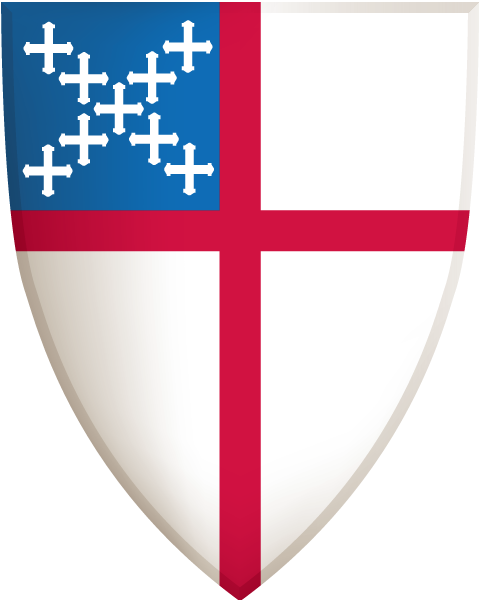Bring me to your holy hill and to your dwelling, that I may go to the altar of God. Ps. 27:5
The Altar/Table is the place where the Holy Eucharist (also known as the Mass, Holy Communion, the Divine Liturgy, or the Lord’s Supper) is the sacrament commanded by Christ for the continual remembrance of his life, death, and resurrection, and his coming again.

When stepping into the Chapel, you will see items used in worship. The following are items visible during worship.
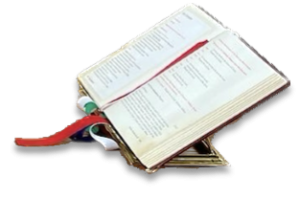
Altar Book – Sometimes also called a Missal. This contains a large print version of the words of the services we offer at the Chapel from which to preside at the Eucharist and other services.

Altar candles – Traditionally used to provide more light for worship, candles have extensive ceremonial use in the Christian liturgical tradition. Lighted candles may be seen to symbolize the light of Christ, or the light of the gospel, or simply to remind the congregation that the time and space for worship are sacred.
 Aumbry and Key – A cupboard or secure receptacle in the side wall of the sanctuary where the reserve sacrament (wafers and wine consecrated during the service) – is kept. The reserve sacrament is taken to sick and shut ins.
Aumbry and Key – A cupboard or secure receptacle in the side wall of the sanctuary where the reserve sacrament (wafers and wine consecrated during the service) – is kept. The reserve sacrament is taken to sick and shut ins.

 Credence Tables – A credence table is a small side table in the sanctuary of a Christian church which is used in the celebration of the Eucharist
Credence Tables – A credence table is a small side table in the sanctuary of a Christian church which is used in the celebration of the Eucharist


Flower vases and stands – Altar flowers can be and are more than mere ornaments. They are the expression of our love for God as well as a means of glorifying his name in all the earth (Psalm 9:9).

Gospel Book – book of readings from the four Gospels for the lectionary cycle. Liturgical use of a distinct Gospel book is normative in The Episcopal Church.
![]() Icons of Mary and Jesus and John the Divine – An icon is a religious work of art, most commonly a painting, but they are not simply works of art; “an icon is a sacred image used in religious devotion.”
Icons of Mary and Jesus and John the Divine – An icon is a religious work of art, most commonly a painting, but they are not simply works of art; “an icon is a sacred image used in religious devotion.”
This icon is of Saint John the Divine, also known as “John the Apostle.” This is the disciple whom Jesus loved, and the one for whom The Chapel of Saint John the Divine, Champaign, Illinois, is named.
In this icon, John is painted in a “portrait,” rather than as part of a Biblical scene. He is depicted as the elderly John “the Theologian.” This is John who, tradition holds, is exiled upon Patmos and writing both the Gospel of John and the Book of The Revelation to John, sixty years or so after the Resurrection of Christ
John is depicted with long white beard and high forehead, holding the Gospel book which led to his title “the Theologian,” shown open to reveal the beginning of John’s Gospel in Greek: “ΕΝ ΑΡΧΗ ΗΝ Ο ΛΟΓΟΣ” or in English, “In the beginning was the Word.”
He is depicted with an Eagle to his left, the symbol of both John and his Gospel. John’s Gospel is the one of the four which most clearly points to the divinity of Christ, and to represent this, an angel is depicted whispering in the ear of the aged theologian.
![]() This icon is of Mary and the boy Jesus. It is modeled after the Byzantine image, called in the West, “Our Lady of Perpetual Help.” In it, Mary’s eyes, filled with compassion and love, are directed toward us. The star on Mary’s veil reminds us that she is the dawn announcing the coming of Christ.
This icon is of Mary and the boy Jesus. It is modeled after the Byzantine image, called in the West, “Our Lady of Perpetual Help.” In it, Mary’s eyes, filled with compassion and love, are directed toward us. The star on Mary’s veil reminds us that she is the dawn announcing the coming of Christ.
Mary’s hands hold her Son securely, and her right hand directs our gaze to him. The Christ Child grasps his mother’s hand as though he is frightened by what he sees. In his hurry to reach his mother, Jesus has almost lost one of his sandals. This portrayal of Jesus is famous because it so clearly depicts his humanity.
On Mary’s left and right we see the reasons for the child’s fear. On the right sits the Archangel Gabriel, holding a cross and four nails. On the left is the Archangel Michael, holding a lance, a pole with a sponge, and a vessel of vinegar. This vision of the instruments of the crucifixion has driven the young Jesus to his mother’s protective embrace. The Greek on the icon read, “MP-ΘΥ” (Μήτηρ Θεοῦ, Mother of God), “ΟΑΜ” (Ὁ Ἀρχάγγελος Μιχαήλ, Michael the Archangel), “ΟΑΓ” (Ὁ Ἀρχάγγελος Γαβριήλ, Gabriel the Archangel) and “IC-XC” (Ἰησοῦς Χριστός, Jesus Christ), respectively.
Both of these beautiful icons were painted by M.J. Greer of Colorado Springs, Colorado, and were donated to the Chapel by Dr. Timothy Fuller.
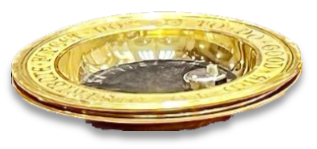 Offering plates – These plates are for collecting offerings from the congregation at our services.
Offering plates – These plates are for collecting offerings from the congregation at our services.

Oblations table (next to organ console) – containing the bread, wine, and the offering plates in which we will collect money and present to God at the Altar.
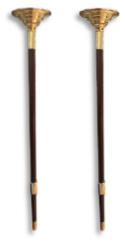
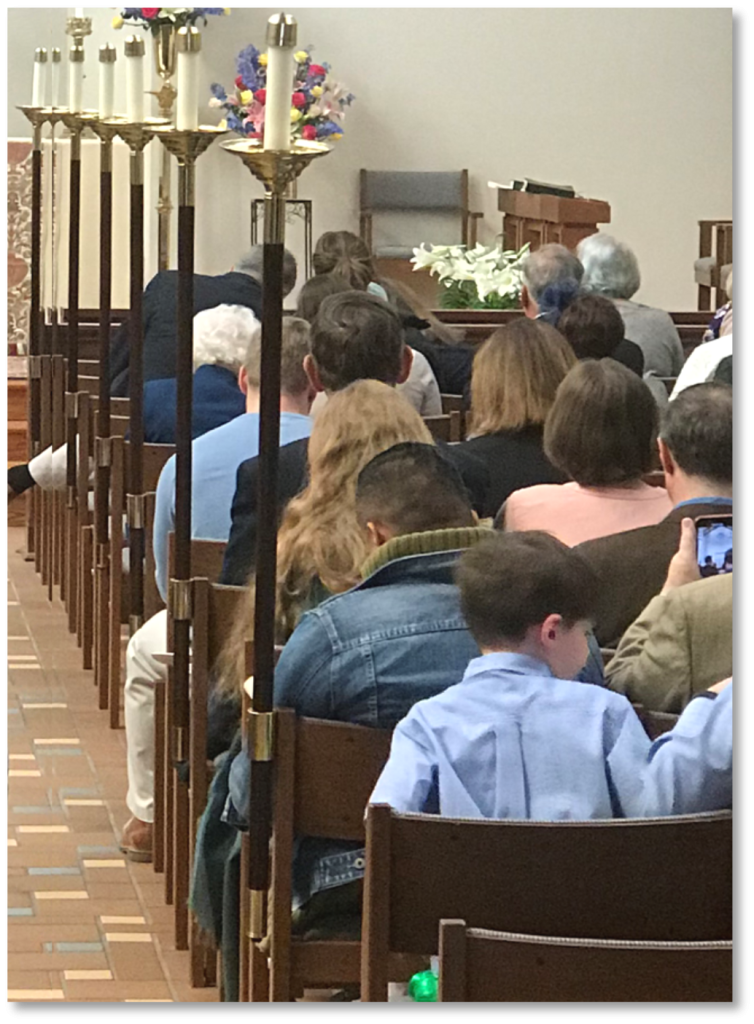
Pew torches – Candle holders affixed to the chairs of the Chapel pew torches that lend an air of importance to festive services.

Prie-dieu – A prayer desk for use during prayer.

Processional crosses (normal, Canterbury Cross, and Lenten Crucifix) – A cross or crucifix mounted on a pole that is carried in a procession by an acolyte called a “crucifer.”
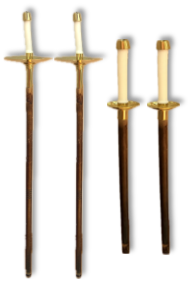
Processional torches – Candles mounted on poles for use in the liturgy, carried by acolytes called “torch bearers.”

Sanctuary Lamp – A candle left lit in the sanctuary of a church indicating the presence of the reserved Sacrament Lit to signify the presence of Christ. It is lighted only when there is reserve sacrament (consecrated bread and wine) in the aumbry.

Thurible – A metal censer suspended from chains used for the burning of aromatic incense strewn on lighted coals during Christian worship.

Incense boat and spoon – A boat is a sacred vessel, traditionally oblong in shape (like a boat), in which incense is kept and transferred to a censer by means of a spoon. Though the Chapel’s boat is round, it is still called a “boat.”

Kneeling cushions at the Altar rail – The Chapel’s kneeling cushions, or “kneelers” were designed by Mary Hallett, organized by June Malone, and needlepointed by many women of the Chapel in memory of Chapel parishioner, Olive Goldman.
 The words in Greek are the beginning of John’s Gospel, “In the beginning was the Word.” Originally created prior to Chapel completion, the original nine kneelers were shortened to fit the size of the new altar rail following Chapel completion in the late 2000s.
The words in Greek are the beginning of John’s Gospel, “In the beginning was the Word.” Originally created prior to Chapel completion, the original nine kneelers were shortened to fit the size of the new altar rail following Chapel completion in the late 2000s.
